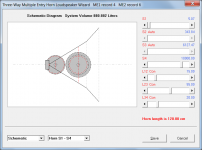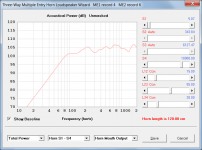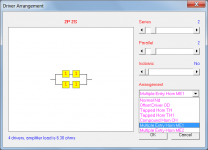\Not sure that I understand. Why can't you just export the horn dimension data for a single segment T = 0.5 hyperbolic-exponential horn from Hornresp, and then use that information to lay out the design, inserting the offset driver at the appropriate point? Any simulations would of course have to be done in AkAbak.
Well you can if there's no flare rate changes.
I'm looking forward to see what you're working on.
From a few years ago. Should be said from time to time:
I have read papers by a great deal of gentlemen that have been called audio giants or pinacle figures. I have never had the priviledge of speaking to them or any form of ciommunication.
It is indeed a rare thing to be able to communicate with the giant whose shoulders we stand on. We all start from a point of knowing little to nothing. Then we add on this with experience. Those who have a great deal of experience like David are indeed showing us the way to get things accomplished not by shear trial and error but with wisdom and clear reasoning. So being able to ask questions and get answers from someone who has been at this for so long a time is indeed a great priviledge. To be able to say that he figured out something before Don Keele for instance is wonderfull. I have no doubt what so ever in the work Mr. McBean has furnished us. I thank you for being able to broaden my own understanding of horn design and function. And I am at this point as a designer because of being pointed in the right direction by Mr. McBean.
You have my profound thanks!
+1!
HornResp and Mmd...
How does HornResp calculate Mmd and the other driver parameters?
I'm trying to configure one of my spreadsheets to automatically generate a Hornresp import file. Here's the equations for the conversions that I'm using at the moment (in Excel form):
(Given Sd, Vas, Fs, Re, Qes and Qms ...)
Cms = Vas/(1.42*10^3*Sd^2)
Mmd = 10^6*1/((2*PI()*Fs)^2*Cms)-10^3*0.575*Sd^1.5
BL =(Re/(Qes*Cms*10^-3*2*PI()*Fs))^0.5
Rms=1/(2*PI()*Fs*Cms*10^-3*Qms)
Example:
Given
Sd=0.1210 m^2
Vas=166.4 l
Fs=39 Hz
Re=5.1 Ohms
Qes=0.542
Qms=8.940
Using the equations above, I get:
Cms = 0.0800 mm/N
Mmd = 183.9 g
BL = 21.9 Tm
Rms = 5.7 Kg/s
However, when I plug those t/s params into HornResp, it's giving me:
Cms = 7.97 E-05 m/N
Mmd = 184.79 g
BL = 21.99 Tm
Rms = 5.73
Quite close, but not exact, so I'm just wondering what could be contributing to the slight difference between the values.
How does HornResp calculate Mmd and the other driver parameters?
I'm trying to configure one of my spreadsheets to automatically generate a Hornresp import file. Here's the equations for the conversions that I'm using at the moment (in Excel form):
(Given Sd, Vas, Fs, Re, Qes and Qms ...)
Cms = Vas/(1.42*10^3*Sd^2)
Mmd = 10^6*1/((2*PI()*Fs)^2*Cms)-10^3*0.575*Sd^1.5
BL =(Re/(Qes*Cms*10^-3*2*PI()*Fs))^0.5
Rms=1/(2*PI()*Fs*Cms*10^-3*Qms)
Example:
Given
Sd=0.1210 m^2
Vas=166.4 l
Fs=39 Hz
Re=5.1 Ohms
Qes=0.542
Qms=8.940
Using the equations above, I get:
Cms = 0.0800 mm/N
Mmd = 183.9 g
BL = 21.9 Tm
Rms = 5.7 Kg/s
However, when I plug those t/s params into HornResp, it's giving me:
Cms = 7.97 E-05 m/N
Mmd = 184.79 g
BL = 21.99 Tm
Rms = 5.73
Quite close, but not exact, so I'm just wondering what could be contributing to the slight difference between the values.
"Devil's Details"
Suspect there are differences in the precision of the constants used in the two venues, yours and David's;
and particularly, the values used for sound velocity and density of the atmosphere.
Regards,
WHG
How does HornResp calculate Mmd and the other driver parameters?
I'm trying to configure one of my spreadsheets to automatically generate a Hornresp import file. Here's the equations for the conversions that I'm using at the moment (in Excel form):
(Given Sd, Vas, Fs, Re, Qes and Qms ...)
Cms = Vas/(1.42*10^3*Sd^2)
Mmd = 10^6*1/((2*PI()*Fs)^2*Cms)-10^3*0.575*Sd^1.5
BL =(Re/(Qes*Cms*10^-3*2*PI()*Fs))^0.5
Rms=1/(2*PI()*Fs*Cms*10^-3*Qms)
Example:
Given
Sd=0.1210 m^2
Vas=166.4 l
Fs=39 Hz
Re=5.1 Ohms
Qes=0.542
Qms=8.940
Using the equations above, I get:
Cms = 0.0800 mm/N
Mmd = 183.9 g
BL = 21.9 Tm
Rms = 5.7 Kg/s
However, when I plug those t/s params into HornResp, it's giving me:
Cms = 7.97 E-05 m/N
Mmd = 184.79 g
BL = 21.99 Tm
Rms = 5.73
Quite close, but not exact, so I'm just wondering what could be contributing to the slight difference between the values.
Suspect there are differences in the precision of the constants used in the two venues, yours and David's;
and particularly, the values used for sound velocity and density of the atmosphere.
Regards,
WHG
Last edited:
How does HornResp calculate Mmd and the other driver parameters?
Hi Brian,
Hornresp uses the following formulas to calculate the driver electro-mechanical parameter values from Thiele-Small parameter values.
Cms = 10 ^ 6 * Vas / (p * c ^ 2 * Sd ^ 2)
Mmd = 1 / (w ^ 2 * Cms * 10 ^ -3) - Xa * p * c * Sd / w
Bl = (Re / (2 * Pi * Fs * Cms * Qes)) ^ 0.5
Rms = 1 / (2 * Pi * Fs * Cms * Qms)
Where:
w = 2 * Pi * Fs
p = density of air (assumed to be 1.205 kilograms per cubic metre)
c = velocity of sound in air (assumed to be 344 metres per second)
Xa = reactive component of acoustical impedance load on both sides of driver vibrating in free air at frequency Fs
Kind regards,
David
Thanks David. From a review of the equations, it seems that the minor differences are mostly due to slight variations wrt assumed constants.
The calculation for Mmr (Mmd = Mms-Mmr) looks interesting though.
The LDC gives the calculation for Mmr as
Mmr = 0.575 * Sd^1.5
Your calculation for Mmr appears to be:
Mmr = Xa * p * c * Sd / w
What sticks out at me is that the LDC's calculation has Sd raised to the power of 1.5, while yours does not. Given that the "p", "c" and "w" components are essentially constants, I'm guessing that Xa a function of Sd^-0.5?
Another thing - I got the generation of the HornResp import file working, but it seems that every parameter needs to be defined in the file in order for the import to work, even the ones with zero values.
The calculation for Mmr (Mmd = Mms-Mmr) looks interesting though.
The LDC gives the calculation for Mmr as
Mmr = 0.575 * Sd^1.5
Your calculation for Mmr appears to be:
Mmr = Xa * p * c * Sd / w
What sticks out at me is that the LDC's calculation has Sd raised to the power of 1.5, while yours does not. Given that the "p", "c" and "w" components are essentially constants, I'm guessing that Xa a function of Sd^-0.5?
Another thing - I got the generation of the HornResp import file working, but it seems that every parameter needs to be defined in the file in order for the import to work, even the ones with zero values.
TSP's Revisited
This is what I recall:
The underlying formula are:
Mms = Mmd + 2*(8p/(3*(pi^2)*a))*(Sd^2)
a = (Sd/pi)^(1/2) - effective piston radius (this is where the Sd^1.5 comes from)
fs = 1/(2*pi*(Mms^(1/2))*Cms)
Thus
Mms = 1/((2*pi*fs*Cms)^2)
Also
The rest is straight forward math to get to Mmd.
Hopefully I kept all the syntax correct.
WHG
Thanks David. From a review of the equations, it seems that the minor differences are mostly due to slight variations wrt assumed constants.
The calculation for Mmr (Mmd = Mms-Mmr) looks interesting though.
The LDC gives the calculation for Mmr as
Mmr = 0.575 * Sd^1.5
Your calculation for Mmr appears to be:
Mmr = Xa * p * c * Sd / w
What sticks out at me is that the LDC's calculation has Sd raised to the power of 1.5, while yours does not. Given that the "p", "c" and "w" components are essentially constants, I'm guessing that Xa a function of Sd^-0.5?
Another thing - I got the generation of the HornResp import file working, but it seems that every parameter needs to be defined in the file in order for the import to work, even the ones with zero values.
This is what I recall:
The underlying formula are:
Mms = Mmd + 2*(8p/(3*(pi^2)*a))*(Sd^2)
a = (Sd/pi)^(1/2) - effective piston radius (this is where the Sd^1.5 comes from)
fs = 1/(2*pi*(Mms^(1/2))*Cms)
Thus
Mms = 1/((2*pi*fs*Cms)^2)
Also
The rest is straight forward math to get to Mmd.
Hopefully I kept all the syntax correct.
WHG
Hi Brian,
Correct - as Bill guessed earlier .
.
Note that the value of Cms used when calculating Mmd, Bl and Rms is taken from the input parameters screen, and is therefore only as precise as the value shown.
Hornresp determines Xa as follows:
Given:
k = 2 * Pi * Fs / c
r = (Sd / Pi) ^ 0.5
x = 2 * k * r
Then:
Xa = K1(x) / (2 * (k * r) ^ 2)
Where the function K1(x) calculates the Struve function H1(x) for any real x.
Well done .
.
Correct.
Kind regards,
David
From a review of the equations, it seems that the minor differences are mostly due to slight variations wrt assumed constants.
Correct - as Bill guessed earlier
Note that the value of Cms used when calculating Mmd, Bl and Rms is taken from the input parameters screen, and is therefore only as precise as the value shown.
I'm guessing that Xa a function of Sd^-0.5?
Hornresp determines Xa as follows:
Given:
k = 2 * Pi * Fs / c
r = (Sd / Pi) ^ 0.5
x = 2 * k * r
Then:
Xa = K1(x) / (2 * (k * r) ^ 2)
Where the function K1(x) calculates the Struve function H1(x) for any real x.
Another thing - I got the generation of the HornResp import file working
Well done
but it seems that every parameter needs to be defined in the file in order for the import to work, even the ones with zero values.
Correct.
Kind regards,
David
First Order Struve Function (H1)
For those that might be interested, the attached ASA article [1] explains David's refinement of the formula presented earlier. From this an Excel UDF could be programmed in VBA.
N.B.: The required Bessel function, BESSELJ(0,z), is already present in Excel.
Regards,
WHG
Reference [1]
For those that might be interested, the attached ASA article [1] explains David's refinement of the formula presented earlier. From this an Excel UDF could be programmed in VBA.
N.B.: The required Bessel function, BESSELJ(0,z), is already present in Excel.
Regards,
WHG
Reference [1]
Attachments
Last edited:
Hornresp Update 3800-150425
Hi Everyone,
CHANGE 1
The Multiple Entry Horn Loudspeaker Wizard tool can now also simulate three-way systems - see Attachments 1 and 2.
To accommodate the new three-way option, the method used to specify the multiple entry system has been modified.
Previously for two-way systems, an OD record was used to specify the horn system and MF drivers at the offset entry point, and an OD1 record was used to specify the HF driver at the horn throat.
Now a Nd record is used to specify the horn system and the HF driver at the horn throat, with the MF drivers at the first offset entry point being specified using a ME1 record and the LF drivers at the second offset entry point being specified using a ME2 record.
A three-way system requires the Nd record to have at least three segments, with both a ME1 record and a ME2 record activated.
A two-way system requires the Nd record to have at least two segments, with a ME1 record activated. If a ME2 record is also activated it will be disregarded if only two segments are specified in the Nd record.
Further details can be found in the 'Multiple Entry Horn Wizard' and 'Two-Way and Three-Way Multiple Entry Horn' sections of the Hornresp Help file.
CHANGE 2
The existing TH1 and the new ME1 and ME2 options can now be selected directly from the Driver Arrangement tool - see Attachment 3.
As always, could you please report any bugs.
Kind regards,
David
Hi Everyone,
CHANGE 1
The Multiple Entry Horn Loudspeaker Wizard tool can now also simulate three-way systems - see Attachments 1 and 2.
To accommodate the new three-way option, the method used to specify the multiple entry system has been modified.
Previously for two-way systems, an OD record was used to specify the horn system and MF drivers at the offset entry point, and an OD1 record was used to specify the HF driver at the horn throat.
Now a Nd record is used to specify the horn system and the HF driver at the horn throat, with the MF drivers at the first offset entry point being specified using a ME1 record and the LF drivers at the second offset entry point being specified using a ME2 record.
A three-way system requires the Nd record to have at least three segments, with both a ME1 record and a ME2 record activated.
A two-way system requires the Nd record to have at least two segments, with a ME1 record activated. If a ME2 record is also activated it will be disregarded if only two segments are specified in the Nd record.
Further details can be found in the 'Multiple Entry Horn Wizard' and 'Two-Way and Three-Way Multiple Entry Horn' sections of the Hornresp Help file.
CHANGE 2
The existing TH1 and the new ME1 and ME2 options can now be selected directly from the Driver Arrangement tool - see Attachment 3.
As always, could you please report any bugs.
Kind regards,
David
Attachments
I'd like to be able to simulate 8th order BP in HR.
Hi Josh,
If all goes according to plan, the feature should be in the next release.
Kind regards,
David
Hi Josh,
If all goes according to plan, the feature should be in the next release.
Kind regards,
David
Wow thanks Dave. You the man.
Methinks there is a multiple entry horn in my future.
This is going to be interesting!
Yowza. The enhancement list just grows and grows.
Impressive!
- Home
- Loudspeakers
- Subwoofers
- Hornresp


